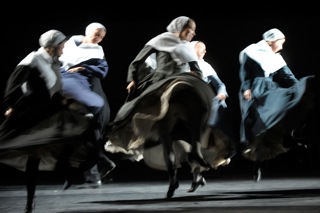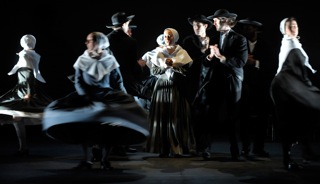Theater Review: An Electrifying “Angel Reapers”
For a polarized nation, both pre-occupied and Occupied, the musical “Angel Reapers” is an inspiring Shaker gift.
Angel Reapers, a theater/dance piece with traditional Shaker hymns. Directed and choreographed by Martha Clarke. Written by Alfred Uhry. Presented by ArtsEmerson: The World on Stage at the Cutler Majestic Theatre, Boston, MA, through November 20.
By Erica H. Adams
The world premiere production of Angel Reapers is an electrifying paradox: it ignites a winter-hued tableau of calm and silence. This vibrant, disquieting blend of modern dance, theater, and a selection of traditional Shaker hymns is fueled by the repressed sexuality of the righteous “Shaking Quakers.” To shake off their sins, 18th century New England “Shakers” (originally a derisive term), whirled and shouted, trembled, and shook during ecstatic worship. Angel Reapers explores how the utopian Shaker society imploded, its initial serene communality scrambled by the revelations of an explosive individualism that had been suppressed.
Shaker history began in Manchester, England when, in 1744, “Mother Ann” led eight Shaker converts from persecution to their New World settlement near Watervliet, New York. By the 19th century, Shakers peaked at about 5,000 believers in nineteen major communities established between 1783 and 1836 in New York, New England, Kentucky, Ohio and Indiana. Known as “Shakers” members of The United Society of Believers in Christ’s Second Appearing were Millenialists who believed that founder Ann Lee (“Mother Ann”) represented Christ’s Second Coming. Today, three converts remain in a Shaker community, active at Sabbathday Lake, Maine. Shakers dedicate their lives to creating a “working Heaven on Earth amidst the boundless opportunities presented by settlement of the New World.”
MacArthur genius award-winning director-choreographer Martha Clarke and writer Alfred Uhry, winner of Pulitzer,Tony and Academy awards, collaborated for a number of years (in starts and stops) on this show. Both New Englanders, the artists were attracted to the Shakers’ turbulent mix of aesthetics, ideology, and sexual denial. Angel Reapers revels in the clash between the quiet and simplicity of Shaker aesthetics and the predictable return of the repressed: the spiritual/political creed of this alternative and spiritual community, based in racial and gender equality, piety and pacifism, is shattered by eruptions of the libido.
In the beginning of the show communality and celibacy are dramatized by just two sets of ladder-back chairs in rows against a gray backdrop. Men and women face each other, sitting in opposite rows. Men in black and white with dark, wide-brimmed hats contrast with women in gray dresses and white bonnets. As feet hit the ground, thunderous rhythms create a dialogue between the thirteen Shaker women and men. Slowly, one by one, chairs and their occupants turn in various directions to express an individuality that eventually turns into frenzied dance. The women swirl in a rainbow of gray-hued dresses. Their flight from gravity is exuberant. In black and white garb, male legs flail out in decisive, spiraling motions. Once individuals tell their stories and release their hidden desires the adherence to an ideology crumbles.
In a post performance talk, Clarke and Uhry spoke about Shaker history. Converts to this sect were a strange mix of orphans, run-away slaves, and farming couples who joined and then deeded their land to the Shakers rather than face bankruptcy. Founder “Mother Ann” had four still-born children, and Clarke suggests that this was the cause for Shaker celibacy. The individual backgrounds of dancers, Clarke explained, facilitated interpretation of Shaker history. The West African origin of one dance, Clarke said, is improvised each night by the troupe’s African American dancer.
The result is an artful evolution from the sedate to the galvanic: dancers end up jolting and sizzling like live wires against an ideological gray expanse. This poetic and distinctively New England haiku offers a visual calm that generates sparks as it gathers tempo. Does excessive want express as well as distort humanity? Between the claims of the social and the individual where is justice? For a polarized nation, both pre-occupied and Occupied, Angel Reapers is an inspiring Shaker gift.
Tagged: Alfred Uhry, Angel Reapers, ArtsEmerson, Martha Clarke




As a writer, I’m so mad about the pepper sprayings at UC Davis that the only way I know to calm down is through, yes, some work of art exactly like the one you describe here.